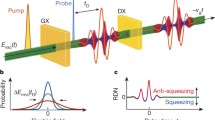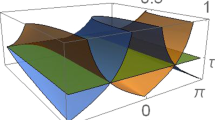Abstract
In quantum field theory, coherent states can be created that have negative energy density, meaning it is below that of empty space, the free quantum vacuum. If no restrictions existed regarding the concentration and permanence of negative energy regions, it might, for example, be possible to produce exotic phenomena such as Lorentzian traversable wormholes, warp drives, time machines, violations of the second law of thermodynamics, and naked singularities. Quantum Inequalities (QIs) have been proposed that restrict the size and duration of the regions of negative quantum vacuum energy that can be accessed by observers. However, QIs generally are derived for situations in cosmology and are very difficult to test. Direct measurement of vacuum energy is difficult and to date no QI has been tested experimentally. We test a proposed QI for squeezed light by a meta-analysis of published data obtained from experiments with optical parametric amplifiers and balanced homodyne detection. Over the last three decades, researchers in quantum optics have been trying to maximize the squeezing of the quantum vacuum and have succeeded in reducing the variance in the quantum vacuum fluctuations to \(-\,15\) dB. To apply the QI, a time sampling function is required. In our meta-analysis different time sampling functions for the QI were examined, but in all physically reasonable cases the QI is violated by much or all of the measured data. This brings into question the basis for QI. Possible explanations are given for this surprising result.









Similar content being viewed by others
References
Bekenstein, J.: If vacuum energy can be negative, why is mass always positive?: Uses of the subdominant trace energy condition. Phys. Rev. D 88, 125005 (2013)
Visser, M.: Lorentzian Wormholes, From Einstein to Hawking. AIP, Springer, New York (1995)
Ford, L., Roman, T.: Restrictions on negative energy density in flat spacetime. Phys. Rev. D 55, 2082 (1997)
Davies, P., Ottewill, A.: Detection of negative energy: 4-dimensional examples. Phys. Rev. D 65, 104014 (2002)
Ford, L.: Negative energy densities in quantum field theory. Int. J. Mod. Phys. A 25, 2355 (2010)
Riek, C., Sulzer, P., Seeger, M., Moskalenko, A.S., Burkard, G., Seletskiy, D.V., Leitenstorfer, A.: Subcycle quantum electrodynamics. Nature 541, 376 (2017)
Ford, L.: Quantum coherence effects and the second law of thermodynamics. Proc. R Soc. Lond. Ser. A 364, 227 (1978)
Ford, L.: Constraints on negative-energy fluxes. Phys. Rev. D 4, 3972 (1991)
Marecki, P.: Application of quantum inequalities to quantum optics. Phys. Rev. A 66, 053801 (2002)
Vahlbruch, H., Mehmet, M., Danzmann, K., Schnabel, R.: Detection of 15 dB squeezed states of light and their application for the absolute calibration of photoelectric quantum efficiency. Phys. Rev. Lett. 117, 110801 (2016)
Marecki, P.: Balanced homodyne detectors in quantum field theory. Phys. Rev. A 77, 012101 (2008)
Marecki, P.: Balanced homodyne detectors and Casimir energy densities. J. Phys. A 41, 164037 (2008)
Pfenning, M.: Quantum inequalities for the electromagnetic field. Phys. Rev. D 65, 024009 (2001)
Gardiner, C., Savage, C.: A multimode quantum theory of a degenerate parametric amplifier in a cavity. Opt. Commun. 50, 173 (1984)
Collett, M., Walls, D.: Squeezing spectra for nonlinear optical systems. Phys. Rev. A 32, 2887 (1985)
Polzit, E., Carri, J., Kimble, H.: Atomic spectroscopy with squeezed light for sensitivity beyond the vacuum-state limit. Appl. Phys. B 55, 279 (1992)
Suzuki, S., Yonezawa, H., Kannari, F., Sasaki, M., Furusawa, A.: 7dB quadrature squeezing at 860nm with periodically poled KTiOPO\(_4\). Appl. Phys. Lett. 89, 061116 (2006)
Takeno, Y., Takahashi, G., Furusawa, A.: Observation of \(-\,9\) dB quadrature squeezing with improvement of phase stability in homodyne measurement. Opt. Exp. 15, 4321 (2007)
Smithey, D., Beck, M., Raymer, M., Faridani, A.: Measurement of the Wigner distribution and the density matrix of a light mode using optical homodyne tomography: application to squeezed states and the vacuum. Phys. Rev. Lett. 70, 1244 (1993)
Wu, L., Kimble, H., Hall, J., Wu, H.: Generation of squeezed states by parametric down conversion. Phys. Rev. Lett. 57, 2520 (1986)
Zhang, T., Goh, K., Chou, C., Lodahl, P., Kimble, H.: Quantum teleportation of light beams. Phys. Rev. A 67, 033802 (2003)
Tanimura, T., Akamatsu, D., Yokoi, Y., Furusawa, A., Kozuma, M.: Generation of a squeezed vacuum resonant on a rubidium \(D_{1}\) line with periodically poled KTiOPO\(_4\). Opt. Lett. 31, 2344 (2006)
Breitenbach, G., Illuminati, F., Shiller, S., Mlynek, J.: Broadband detection of squeezed vacuum: a spectrum of quantum states. Europhys. Lett. 44(2), 192 (1998)
Aoki, T., Takahashi, G., Furusawa, A.: Squeezing at 946nm with periodically poled KTiOPO\(_4\). Opt. Exp. 14, 6930 (2006)
Hetet, G., Gloecki, O., Pilynas, K., Harb, C., Buchler, B., Bachor, H., Lam, P.: Squeezed light for bandwidth-limited atom optics experiments at the rubidium D1 line. J. Phys. B 40, 221 (2007)
Hirano, T., Kotani, K., Ishibashi, T., Okude, S., Kuwamoto, T.: 3 dB squeezing by single-pass parametric amplification in a periodically poled KTiOPO\(_4\) crystal. Opt. Lett. 30, 1722 (2005)
Fewster, C.J., Teo, E.: Bounds on negative energy densities in static space-times. Phys. Rev. D 59, 104016 (1999)
Acknowledgements
We are very grateful to Peter Milonni and Larry Ford for helpful discussions and comments. We would like to thank the Institute for Advanced Studies At Austin and H. E. Puthoff for supporting this work.
Author information
Authors and Affiliations
Corresponding author
Additional information
Publisher's Note
Springer Nature remains neutral with regard to jurisdictional claims in published maps and institutional affiliations.
Appendix A: Derivation of Marecki’s Quantum Inequality
Appendix A: Derivation of Marecki’s Quantum Inequality
Marecki [9] derives a Quantum Inequality for squeezed light and squeezed vacuum following the general approach of Fewster and Teo [27] and Pfenning [13]. We briefly describe his derivation to clarify the comparisons to the OPA data. Marecki defines the operator variance of the normally ordered electric field\(\ \varDelta E^{2}(x,t)\):
and considers a time sampling of the field squared
where
He also mentions the possibility of including a frequency sampling function \(\mu _{p}=\)\(\mu (\omega _{p}-\omega _{0})\), peaked at \(\omega _{0}\), that reflects the frequency response of the apparatus measuring the variance. Since it is necessary to use a frequency sampling function to get finite results for \(\varDelta ,\) we will include it in our derivations. However, we note that there is a potential consistency issue using an independently selected frequency sampling function since the time sampling function f(t) implies a frequency selection determined by its Fourier transform. Using the Coulomb gauge, the vector potential is
where \(\omega _{k}=|k|\) and \(\alpha \) denotes the two polarization states which are normalized and orthogonal to \({\mathbf {k}}\). In the exponentials, \(kx=-{\mathbf {k}}\cdot {\mathbf {x}}+\omega t\) represents the scalar product. The electric field operator is
The expectation value of the time sampled free vacuum field squared is
where we have used the commutator \([a_{\alpha }({\mathbf {p}}),a_{\beta }^{\dag }({\mathbf {k}})]=\delta _{\alpha \beta }\delta ({\mathbf {p}}-{\mathbf {k}})\) and included the frequency function. The Fourier transform of the time sampling function f(t) is defined as
Integrating Eq. A.7 over k, using the unity normalization of the polarization vectors \( {\displaystyle \sum \limits _{i}} {\mathbf {e}}_{i}^{\alpha }({\mathbf {k}}){\mathbf {e}}_{i}^{\alpha }({\mathbf {p}})=1\) , and that \(f_{FT}(0)=1/2\pi \) because of the f(t) nomalization, gives
Substituting this result into the expression for the variance \(\varDelta \) gives, after integration over time,
where HC is the Hermitian conjugate. To derive a quantum inequality, Marecki defines a vector operator \(B_{i}(\omega )\) and computes the integral over frequency of the norm of \({\mathbf {B}}\) which has to be positive
We choose
and substitute this into Eq. A.11, and use the result in Eq. A.10. After taking the expectation value with respect to state A, we obtain Eq. 4 in Sect. 2. Note that in Eq. A.12, \((f^{1/2})_{FT}^{*}(\omega - \omega _{p})\) means the complex conjugate of the Fourier transform of the square root of f(t).
Rights and permissions
About this article
Cite this article
Maclay, G.J., Davis, E.W. Testing a Quantum Inequality with a Meta-analysis of Data for Squeezed Light. Found Phys 49, 797–815 (2019). https://doi.org/10.1007/s10701-019-00286-8
Received:
Accepted:
Published:
Issue Date:
DOI: https://doi.org/10.1007/s10701-019-00286-8




